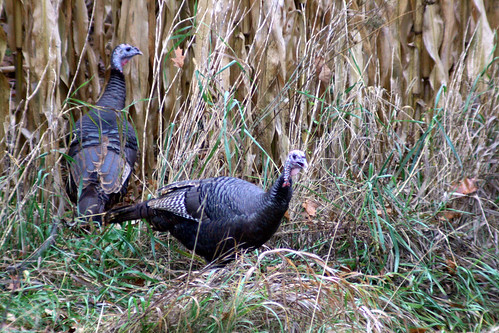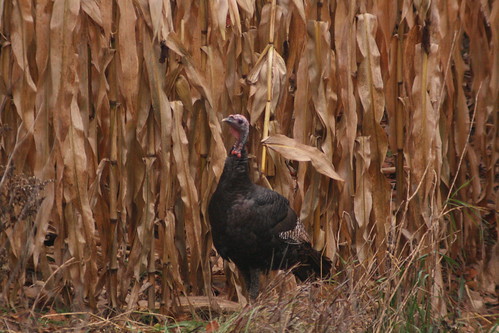I was up early Sunday morning and in a bit of a half-sleep reverie when it occurred to me that – most unusually – there was rather a lot of noise outside my bedroom window.
When you get right down to it, I sleep about eighty-five feet from the edge of a cornfield, often indoors. Generally, there isn’t an awful lot of noise out there for the would-be sleeper or his next-day relative, the dazed and confused early morning riser, to contend with. What little audio ambience there is would typically be of the pastoral background sort – birds chirping, wind rustling through the trees, that sort of thing.
These noises, though were different. My brain needed to assimilate and assess the information with which it was being bombarded. First, I determined that there were noises of many varieties, and lots of them. Whatever was happening out there was not taking place by stealth. I decided to confer the status of “racket” upon what I was hearing. With that taxonomic decision out of the way, I proceeded to consider whether there was possibly more to learn about the situation. After some careful reflection, I decided that quite a number of the many noises were similar; I decided to assume that there was a lot of something causing this cacophony. But what could those somethings be? Examining my audio memory banks, I could not recall ever hearing this particular sort of racket before.
I was beginning to get stumped about how to resolve this conundrum, so I decided to just look out the damn window. This is what I saw:
You may not be able to tell from the photographic evidence, but Spouse and I had not one, not two, but something like thirty turkeys roaring around our backyard. Those of you who know your wild turkeys won’t have difficulty with that part of the proposition (you may even know that there are many accepted names for a group of turkeys, including “gang”, “posse”, “crop”, “dole” and “raffle”, or you might – like Spouse – just have the What Bird app for your iPhone). You may, however, have some more difficulty with the following assertion: they were barking. And chasing each other around in circles.
I realize that the notion of barking turkeys may be somewhat controversial, particularly among those of you with an ornithological background. I am well aware of the prevailing wisdom to the effect that turkeys emit a sort of “gobble-gobble” noise, and I am not denying that some of the din arising outside our window was indeed of this variety. I think you can understand me, however, when I tell you that those noises were far less intriguing to me than the unmistakable barking also taking place. There are those who will refuse to believe it, despite my previous mostly unblemished record as a person who relates at least some of the truth not infrequently; these untrusting souls will say that I am spreading heresy of a sort. All I can tell you, gentle reader, is what I heard; I’m not here to pick any ideological battles, least of all with those inclined to amass specialized knowledge of so arcane a subject as the vocal habits of poultry. Perhaps the turkeys were rehearsing – poorly – for their performance of the woof-woof-woof version of Jingle Bells at the upcoming turkey Christmas pageant (what a sombre affair I suppose that gathering would be, given the likely solemn associations most turkeys must have between this time of year and the premature demise of a loved one or two). Perhaps they were having a bit of a laugh and simply taking the piss out of a local dog that needed a good mocking. I am unable to express a truly informed opinion on the matter.
Let’s just agree, for the sake of moving on to the discussion below, that I do not know why the turkeys were barking and leave it at that. Equally concerning was their physical behaviour: rocketing around in large circles and colliding with one another, they looked rather like NASCAR for domesticated fowl. It was a puzzling display, any way you slice it, and Spouse and I stared in first silent disbelief, shortly followed by full-throated laughter.
We resolved to deal with this extraordinary situation in the fashion of 21st-century man; by educating ourselves about our guests. Taking iPhones to hand, we quickly learned a few salient facts about our bizarre new visitors. We learned, for example, that wild turkeys are native to North America and that, as the largest ground-nesting bird indigenous to the continent, they were so beloved by the hungry, marauding and colonizing Europeans that they were actually taken from Mexico to Europe in the 1500s, domesticated and then brought back to the continent by settlers on the Atlantic coast. Meleagris gallopavo was treated rather roughly, however, by the colonists: as the continent was civilized, it was also deforested and the turkeys’ reacted to this treatment of their habitat by dying in droves. Evidently, in many areas (such as Ontario, in 1909) locally indigenous populations were wiped out entirely, leading many jurisdictions to import wild turkeys from other places and to re-introduce them to the habitat in an effort to get them re-established. As recently as 1984, there were only 274 wild turkeys in all of Ontario. Aggressive conservation and protection laws seem to have worked well for Wild Tom in Ontario: by some reports, there are more than 100,000 of them now (many of them in my backyard, apparently). Omnivorous eaters (occasionally dining on snakes and frogs), wild turkeys can fly quite well (yes, I know, I’ve seen that episode of WKRP in Cincinnati too, but these are wild turkeys we’re talking about; really, you must pay more careful attention) and like to roost in trees at night.
Also, I learned that there is a National Wild Turkey Federation – apparently. I was, however, confounded to find no mention whatsoever of barking turkeys in the serious literature available on the Internet. This lacuna in the otherwise estimable record of the Internet at knowing everything, taken alone, would have been a disappointment for me. Adding insult to injury, however, the only reference to barking turkeys that I located via Google was this distressing foray into fiction via the troubling sub-genre of poultry porn by Alexandra OneLight (actually, I don’t know whether the article is or is not pornographic – when I saw some passages near the beginning about the mating habits of wild turkeys, I simply assumed the worst).
All in all, it was quite an educational morning, as you can see. If that were not enough excitement for one day, Spouse and I popped out to pick up some grub and a cup of tea this evening; upon our return, as we were travelling up the driveway, I saw a pair of beady little eyes staring back at me from the middle of the front lawn, about thirty feet from the edge of the driveway. I slowed down to see what it was.
Skunk!
I didn’t stick around long enough to learn anything about him.



I’m not sure if it was a pet or wild — we’re not too far from a canyon where wild things live — but I ran into a skunk one early morning on my bike: it saw me, the tail went up and I went wide.
The native Juniorvania fauna keep getting augmented with fascinating entries; perhaps the barking was an evolutionary camouflage, of sorts, to blind dogs everywhere in Ontario: don’t mind me, I’m just another dog passing through — nothing to sniff here, please move on.
I always like to cite the story that Ben Franklin preferred the Wild Turkey as the national bird of America (“… though a little vain & silly, a Bird of Courage …”).